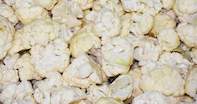
Scientific name: Brassica Oleracea var.
Botrytis Common Name: Cauliflower
Plant Description
Cauliflower is part of the same plant family as broccoli, Brussel sprouts, cabbage and kale. Cauliflower is said to have originated in South West Asia or Turkey.
It is descendent from a wild cabbage and after undergoing various changes, it appeared as the vegetable we know today over 2000 years ago.
The plant has dark green ribbed leaves with serrated edges surrounding a head of a tightly packed ball of white flower heads that make up the main edible part of the plant. The edible head of immature flowers is also called the “curd”.
Uses
The plant is a good source of Potassium and Vitamin B and C. It is used as a healthy source of carbohydrates and fibre. Both the leaves and florets are edible although the main edible part is the head of florets or curd.
The curd is broken apart and the florets are steamed or boiled for a short time. The florets are also eaten raw in salads. They are also used to make soup.
Soil Requirements and Preparation
It is best to plant cauliflower in sandy loam soil that is rich in organic content and that drains well. Soil pH should be between 6.5 and 7. Prepare the soil well ahead of planting to give any organic material that has been incorporated time to settle.
Start by taking soil samples. If there are any additives required like lime for pH or additional organic material like compost or manure, then these are spread as per soil sample recommendation. This is done about four weeks before planting.
If a green cover crop is to be planted prior to the cauliflower crop, this should be done about 12 weeks before planting the cauliflower to give the cover crop time to establish. At about four weeks from planting, the green cover crop is cut or slashed.
This is ploughed into the top 500 mm of soil along with compost, manure, lime and superphosphate, if required. Follow within a week with a disc harrow which will level the ground and cut up and further incorporate any vegetative debris into the top 20 cm of soil. In the final week before planting, run over the plant area with a disc harrow for a final time.
This incorporates the pre-plant fertilizer application and at the same time killing any weeds that may have started to grow and levelling the plant area in preparation for planting.